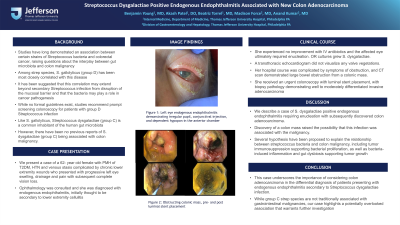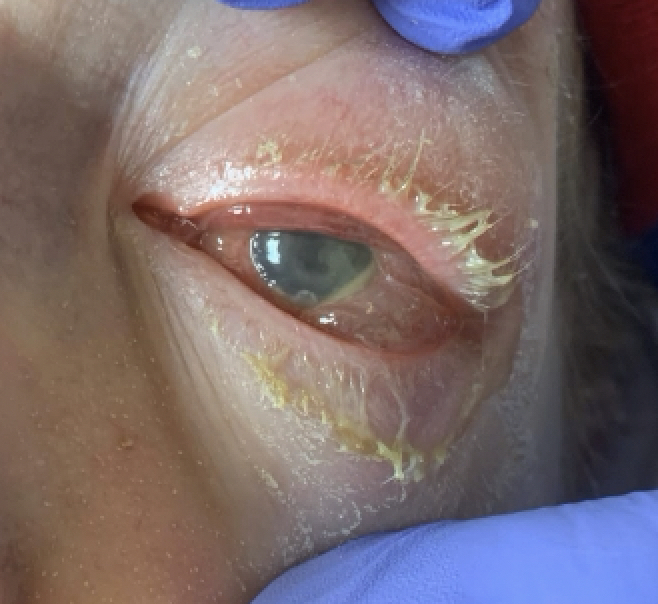Tuesday Poster Session
Category: Colon
P3743 - Streptococcus Dysgalactiae Positive Endogenous Endophthalmitis Associated With New Colon Adenocarcinoma
Tuesday, October 29, 2024
10:30 AM - 4:00 PM ET
Location: Exhibit Hall E

Has Audio

Benjamin Young, MD
Thomas Jefferson University Hospital
Philadelphia, PA
Presenting Author(s)
Benjamin Young, MD1, Akash Patel, DO1, Beatriz Torre, MD2, Madison Force, MD1, Anand Kumar, MD, MPH1
1Thomas Jefferson University Hospital, Philadelphia, PA; 2Thomas Jefferson University, Philadelphia, PA
Introduction: Studies have long demonstrated an association between certain strains of streptococcus bacteria and colorectal cancer, raising questions about the interplay between gut microbiota and colon malignancy. Among strep species, S. gallolyticus (group D) has been most closely correlated with this disease. It has been suggested that this correlation may extend beyond secondary streptococcus infection from disruption of the mucosal barrier and that the bacteria may play a role in cancer pathogenesis. While no formal guidelines exist, studies recommend prompt screening colonoscopy for patients with group D Streptococcus infection. Like S. gallolyticus, Streptococcus dysgalactiae (group C) is a common inhabitant of the human gut microbiota. However, there have been no previous reports of Streptococcus dysgalactiae (group C) being associated with colon malignancy.
Case Description/Methods: We describe a case of a 62-year-old female who presented with progressive left eye swelling, drainage and pain with subsequent complete vision loss. She was diagnosed with endogenous endophthalmitis, which did not improve with IV antibiotics. The affected eye ultimately required enucleation and OR cultures grew S. dysgalactiae. A transthoracic echocardiogram did not visualize any valve vegetations. Her hospital course was complicated by symptoms of obstruction, and CT scan demonstrated large bowel obstruction from a colonic mass. She received an urgent colonoscopy with luminal stent placement, with biopsy pathology demonstrating well to moderately differentiated invasive adenocarcinoma.
Discussion: We describe a case of streptococcus dysgalactiae positive endogenous endophthalmitis requiring enucleation with subsequently discovered colon adenocarcinoma. Discovery of a colon mass raised the possibility that this infection was associated with the malignancy. Several hypotheses have been proposed to explain the relationship between streptococcus bacteria and colon malignancy including tumor immunosuppression supporting bacterial proliferation, as well as bacteria- induced inflammation and gut dysbiosis supporting tumor growth. This case underscores the importance of considering colon adenocarcinoma in the differential diagnosis of patients presenting with endogenous endophthalmitis secondary to Streptococcus dysgalactiae infection. While group C strep species are not traditionally associated with gastrointestinal malignancies, our case highlights a potentially overlooked association that warrants further investigation.

Disclosures:
Benjamin Young, MD1, Akash Patel, DO1, Beatriz Torre, MD2, Madison Force, MD1, Anand Kumar, MD, MPH1. P3743 - Streptococcus Dysgalactiae Positive Endogenous Endophthalmitis Associated With New Colon Adenocarcinoma, ACG 2024 Annual Scientific Meeting Abstracts. Philadelphia, PA: American College of Gastroenterology.
1Thomas Jefferson University Hospital, Philadelphia, PA; 2Thomas Jefferson University, Philadelphia, PA
Introduction: Studies have long demonstrated an association between certain strains of streptococcus bacteria and colorectal cancer, raising questions about the interplay between gut microbiota and colon malignancy. Among strep species, S. gallolyticus (group D) has been most closely correlated with this disease. It has been suggested that this correlation may extend beyond secondary streptococcus infection from disruption of the mucosal barrier and that the bacteria may play a role in cancer pathogenesis. While no formal guidelines exist, studies recommend prompt screening colonoscopy for patients with group D Streptococcus infection. Like S. gallolyticus, Streptococcus dysgalactiae (group C) is a common inhabitant of the human gut microbiota. However, there have been no previous reports of Streptococcus dysgalactiae (group C) being associated with colon malignancy.
Case Description/Methods: We describe a case of a 62-year-old female who presented with progressive left eye swelling, drainage and pain with subsequent complete vision loss. She was diagnosed with endogenous endophthalmitis, which did not improve with IV antibiotics. The affected eye ultimately required enucleation and OR cultures grew S. dysgalactiae. A transthoracic echocardiogram did not visualize any valve vegetations. Her hospital course was complicated by symptoms of obstruction, and CT scan demonstrated large bowel obstruction from a colonic mass. She received an urgent colonoscopy with luminal stent placement, with biopsy pathology demonstrating well to moderately differentiated invasive adenocarcinoma.
Discussion: We describe a case of streptococcus dysgalactiae positive endogenous endophthalmitis requiring enucleation with subsequently discovered colon adenocarcinoma. Discovery of a colon mass raised the possibility that this infection was associated with the malignancy. Several hypotheses have been proposed to explain the relationship between streptococcus bacteria and colon malignancy including tumor immunosuppression supporting bacterial proliferation, as well as bacteria- induced inflammation and gut dysbiosis supporting tumor growth. This case underscores the importance of considering colon adenocarcinoma in the differential diagnosis of patients presenting with endogenous endophthalmitis secondary to Streptococcus dysgalactiae infection. While group C strep species are not traditionally associated with gastrointestinal malignancies, our case highlights a potentially overlooked association that warrants further investigation.

Figure: Figure 1: Left eye endogenous endophthalmitis demonstrating irregular pupil, conjunctival injection, and dependent hypopon in the anterior chamber.
Disclosures:
Benjamin Young indicated no relevant financial relationships.
Akash Patel indicated no relevant financial relationships.
Beatriz Torre indicated no relevant financial relationships.
Madison Force indicated no relevant financial relationships.
Anand Kumar: Boston Scientific – Consultant. Olympus – Consultant.
Benjamin Young, MD1, Akash Patel, DO1, Beatriz Torre, MD2, Madison Force, MD1, Anand Kumar, MD, MPH1. P3743 - Streptococcus Dysgalactiae Positive Endogenous Endophthalmitis Associated With New Colon Adenocarcinoma, ACG 2024 Annual Scientific Meeting Abstracts. Philadelphia, PA: American College of Gastroenterology.
